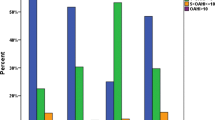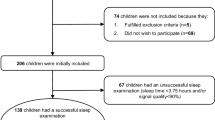Abstract
Purpose
The objectives of this study were to examine the prevalence of obstructive sleep apnea (OSA) in primary school children, relationships between OSA and tonsillar hypertrophy, adenoid, and patency of the nasal cavity, and the effects of the tonsillar hypertrophy and adenoid on the nasal patency.
Methods
An examination of the palatine tonsils and anterior rhinoscopy, completion of a questionnaire survey, a measurement of nasal resistance, an examination for sleep apnea at home using portable polysomnography device, and radiography of pharyngeal tonsil were performed in 152 primary school children.
Results
The obstructive apnea hypopnea index (O-AHI) increased with enlargements in the palatine tonsils. The adenoidal nasopharyngeal ratio (A/N ratio) decreased with advances in grade. A significant difference was observed in the O-AHI between those with and without adenoid. The median value of the O-AHI increased with advances in grade. The nasal resistance was significantly higher in the group with adenoid compared as in the group without. It was also higher in the nasal disease group with OSA than in the group without. Full polysomnography(PSG) was recommended in 16 (10.5 %) of 152 who underwent the examination using the portable polysomnography device, and of the eight who underwent PSG, six (75 %) were confirmed to have OSA, while its prevalence in all subjects was estimated as 7.9 %.
Conclusions
Disturbances in nasal respiration as well as tonsillar hypertrophy and adenoid were found to be a risk factor of OSA in primary school children.

Similar content being viewed by others
References
Jeans WD, Fernando DC, Maw AR, Leighton BC (1981) A longitudinal study of the growth of the nasopharynx and its contents in normal children. Br J Radiol 54:117–121
Papaioannou G, Kambas I, Tsaoussoglou M, Panaghiotopoulou-Gartagani P, Chrousos G, Kaditis AG (2013) Age-dependent changes in the size of adenotonsillar tissue in childhood: implications for sleep-disordered breathing. J Pediatr 162:269–274
Konno A, Togawa K, Hoshino T (1980) The effect of nasal obstruction in infancy and early childhood upon ventilation. Laryngoscope 90:699–707
American Academy of Sleep Medicine (2005) International classification of sleep disorders: diagnostic and coding manual, 2nd edn. American Academy of Sleep Medicine, Westchester
Marcus CL, Moore RH, Rosen CL, Giordani B, Garetz SL, Taylor HG, Mitchell RB, Amin R, Katz ES, Arens R, Paruthi S, Muzumdar H, Gozal D, Thomas NH, Ware J, Beebe D, Snyder K, Elden L, Sprecher RC, Willging P, Jones D, Bent JP, Hoban T, Chervin RD, Ellenberg SS, Redline S, Childhood Adenotonsillectomy Trial (CHAT) (2013) A randomized trial of adenotonsillectomy for childhood sleep apnea. N Engl J Med 368:2366–2376
Ali NJ, Pitson DJ, Stradling JR (1993) Snoring, sleep disturbance, and behaviour in 4–5 year olds. Arch Dis Child 68:360–366
Gislason T, Benediktsdóttir B (1995) Snoring, apneic episodes, and nocturnal hypoxemia among children 6 months to 6 years old. An epidemiologic study of lower limit of prevalence. Chest 107:963–966
Redline S, Tishler PV, Schluchter M, Aylor J, Clark K, Graham G (1999) Risk factors for sleep-disordered breathing in children. Associations with obesity, race, and respiratory problems. Am J Respir Crit Care Med 159:1527–1532
Unno T, Naitoh Y, Sakamoto N, Horikawa H (1986) Nasal resistance measured by anterior rhinomanometry. Rhinology 24:49–55
Georgitis JW (1985) The applicability of rhinomanometry in nonatopic children: comparison of three techniques. J Allergy Clin Immunol 75:614–620
Brodsky L (1989) Modern assessment of tonsils and adenoids. Pediatr Clin N Am 36:1551–1569
Iber C, Ancoli-Israel SA, Chesson A, Quan SF, for the American Academy of Sleep Medicine (2007) The AASM manual for the scoring of sleep and associated events: rules, terminology and technical specifications, 1st edn. American Academy of Sleep Medicine, Westchester
Fujioka M, Young LW, Girdany BR (1979) Radiographic evaluation of adenoidal size in children: adenoidal-nasopharyngeal ratio. AJR Am J Roentgenol 133:401–404
Nakayama M, Koike S, Kuriyama S, Suzuki M, Nakamura Y, Yamamoto K, Murakami S, Gozal D (2013) Seasonal variation in a clinical referral pediatric cohort at risk for obstructive sleep apnea. Int J Pediatr Otorhinolaryngol 77:266–269
Gozal D, Shata A, Nakayama M, Spruyt K (2011) Seasonal variability of sleep-disordered breathing in children. Pediatr Pulmonol 46:581–586
Baugh RF, Archer SM, Mitchell RB, Rosenfeld RM, Amin R, Burns JJ, Darrow DH, Giordano T, Litman RS, Li KK, Mannix ME, Schwartz RH, Setzen G, Wald ER, Wall E, Sandberg G, Patel MM (2011) American Academy of Otolaryngology-Head and Neck Surgery Foundation. Clinical practice guideline: tonsillectomy in children. Otolaryngol Head Neck Surg 144:S1–S30
Kobayashi R, Miyazaki S, Karaki M, Kobayashi E, Karaki R, Akiyama K, Matsubara A, Mori N (2011) Measurement of nasal resistance by rhinomanometry in 892 Japanese elementary school children. Auris Nasus Larynx 38:73–76
Kobayashi R, Miyazaki S, Karaki M, Hara H, Kikuchi A, Kitamura T, Mori N (2012) Nasal resistance in Japanese elementary school children: determination of normal value. Acta Otolaryngol 132:197–202
Nakata S, Miyazaki S, Ohki M, Morinaga M, Noda A, Sugiura T, Sugiura M, Teranishi M, Katayama N, Nakashima T (2007) Reduced nasal resistance after simple tonsillectomy in patients with obstructive sleep apnea. Am J Rhinol 21:192–195
Joshua B, Bahar G, Sulkes J, Shpitzer T, Raveh E (2006) Adenoidectomy: long-term follow-up. Otolaryngol Head Neck Surg 135:576–580
Rizzi M, Onorato J, Andreoli A, Colombo S, Pecis M, Marchisio P, Morelli M, Principi N, Esposito S, Sergi M (2002) Nasal resistances are useful in identifying children with severe obstructive sleep apnea before polysomnography. Int J Pediatr Otorhinolaryngol 65:7–13
Acknowledgments
We thank Ms. Naomi Kubo, Ms. Miho Shirafuji, and Mr. Takayuki Shinota for their assistance with the rhinomanometry measurements and statistical analysis. We are also grateful to Ms. Ikuko Morita, who analyzed the portable monitor device data.
Declaration of interest
The authors report no conflicts of interest. The authors alone are responsible for the content and writing of the paper.
Author information
Authors and Affiliations
Corresponding author
Rights and permissions
About this article
Cite this article
Kobayashi, R., Miyazaki, S., Karaki, M. et al. Obstructive sleep apnea in Asian primary school children. Sleep Breath 18, 483–489 (2014). https://doi.org/10.1007/s11325-013-0909-1
Received:
Revised:
Accepted:
Published:
Issue Date:
DOI: https://doi.org/10.1007/s11325-013-0909-1




